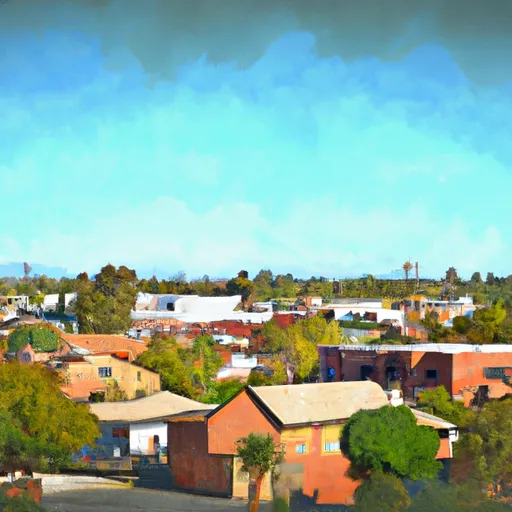-
 Snoflo Premium
Snoflo Premium
Get unlimited access to all our content
With no Ad interruptions! - Start Your Free Trial Login with existing account
Woodbridge
Eden Index
Climate
9.4
•
Recreation
2.5
•
Community
2.9
•
Safeguard
5.4/10

Woodbridge, located in San Joaquin County, California, enjoys a Mediterranean climate characterized by hot, dry summers and mild, wet winters. Summers in Woodbridge are typically sunny with temperatures averaging around 90°F (32°C), occasionally reaching over 100°F (38°C). Winters are cooler, with temperatures ranging from the mid-40s°F (7°C) to the mid-50s°F (12°C). Precipitation is relatively low, averaging around 12 inches per year, mainly falling between November and March.
Woodbridge is surrounded by the beautiful Mokelumne River and Lodi Lake, making it a paradise for hydrology enthusiasts. The Mokelumne River provides opportunities for boating, fishing, and wildlife observation, with its crystal-clear waters and serene surroundings. Lodi Lake, with its peaceful atmosphere and lush vegetation, is perfect for kayaking, paddleboarding, and picnicking.
In addition to its hydrology attractions, Woodbridge offers various outdoor recreation opportunities. The nearby Lodi Wine Country provides wine lovers with an array of vineyards and wineries to explore. Visitors can indulge in wine tastings, vineyard tours, and even participate in grape stomping events. Outdoor enthusiasts can also enjoy hiking, biking, and birdwatching in the nearby nature preserves and parks like the Cosumnes River Preserve and the Isenberg Crane Reserve.
Overall, Woodbridge, California, offers a delightful climate, ample hydrology attractions, and diverse outdoor recreation opportunities for everyone to enjoy.
What is the Eden Index?
The Snoflo Eden Index serves as a comprehensive rating system for regions, evaluating their desirability through a holistic assessment of climate health, outdoor recreation opportunities, and natural disaster risk, acknowledging the profound impact of these factors on livability and well-being.
Climate Health Indicator (CHI): 9.4
Woodbridge receives approximately
471mm of rain per year,
with humidity levels near 58%
and air temperatures averaging around
16°C.
Woodbridge has a plant hardyness factor of
9, meaning
plants and agriculture in this region tend to thrive here all year round.
By considering the ideal temperature range, reliable water supplies, clean air, and stable seasonal rain or snowpacks, the Climate Health Indicator (CHI) underscores the significance of a healthy climate as the foundation for quality living.
A healthy climate is paramount for ensuring a high quality of life and livability in a region, fostering both physical well-being and environmental harmony. This can be characterized by ideal temperatures, reliable access to water supplies, clean air, and consistent seasonal rain or snowpacks.
Weather Forecast
Streamflow Conditions
San Joaquin
Area Rivers
San Joaquin
Snowpack Depths
San Joaquin
Reservoir Storage Capacity
San Joaquin
Groundwater Levels
Recreational Opportunity Index (ROI): 2.5
The Recreational Opportunity Index (ROI) recognizes the value of outdoor recreational options, such as parks, hiking trails, camping sites, and fishing spots, while acknowledging that climate plays a pivotal role in ensuring the comfort and consistency of these experiences.
Access to outdoor recreational opportunities, encompassing activities such as parks, hiking, camping, and fishing, is crucial for overall well-being, and the climate plays a pivotal role in enabling and enhancing these experiences, ensuring that individuals can engage in nature-based activities comfortably and consistently.
Camping Areas
| Campground | Campsites | Reservations | Toilets | Showers | Elevation |
|---|---|---|---|---|---|
| Rancho Seco Rec Area | None | 252 ft | |||
| Dos Reis | None | 27 ft | |||
| Sharpe RV Military | None | 26 ft | |||
| Westgate Landing Regional Park | 14 | -12 ft |
Nearby Ski Areas
Catastrophe Safeguard Index (CSI):
The Catastrophe Safeguard Index (CSI) recognizes that natural disaster risk, encompassing floods, fires, hurricanes, and tornadoes, can drastically affect safety and the overall appeal of an area.
The level of natural disaster risk in a region significantly affects safety and the overall livability, with climate change amplifying these risks by potentially increasing the frequency and intensity of events like floods, fires, hurricanes, and tornadoes, thereby posing substantial challenges to community resilience and well-being.
Community Resilience Indicator (CRI): 2.9
The Community Resilience Indicator (CRI) recognizes that education, healthcare, and socioeconomics are crucial to the well-being of a region. The CRI acknowledges the profound impact of these elements on residents' overall quality of life. By evaluating educational resources, healthcare accessibility, and economic inclusivity, the index captures the essential aspects that contribute to a thriving community, fostering resident satisfaction, equity, and social cohesion.

